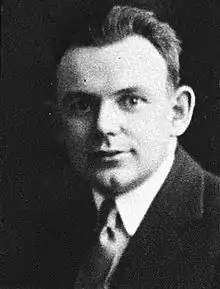George Black | |
|---|---|
 | |
| Member of the New Zealand Parliament for Motueka | |
| In office 14 November 1928 – 17 October 1932 | |
| Preceded by | Richard Hudson |
| Succeeded by | Keith Holyoake |
| Personal details | |
| Born | George Charles Cecil Black 21 November 1903 Reefton, New Zealand |
| Died | 17 October 1932 (aged 28) Makara, New Zealand |
| Political party | United |
George Charles Cecil Black (21 November 1903 – 17 October 1932) was a member of the House of Representatives for Motueka electorate, in the South Island of New Zealand, initially as a representative of the United Party and from early 1931 as an Independent. He committed suicide and was succeeded as MP by Keith Holyoake.
Early life
Born in Reefton on 21 November 1903, Black was the son of George James and Marianne Catherine Black.[1][2] In 1923, Black became a Parliamentary Clerk of Committees.[1]
Member of Parliament
| Years | Term | Electorate | Party | ||
|---|---|---|---|---|---|
| 1928–1931 | 23rd | Motueka | United | ||
| 1931 | Changed allegiance to: | Independent | |||
| 1931–1932 | 24th | Motueka | Independent | ||
Black represented the Motueka electorate in the House of Representatives from 1928 to 1932.
In the 1928 election, aged only 24, he stood as a United Party candidate and follower of Sir Joseph Ward and was successful.[3] He unexpectedly beat the Reform Party incumbent of 14 years,[4] Richard Hudson, and became the youngest MP at the time.[1] He was appointed junior whip by the United Party.[5]
In Parliament, Black refused to support the Finance Bill that proposed cuts to public service salaries and voted with the Labour Party,[6] and in January 1931 he also opposed the decision to suspend construction of the Kawatiri–Inangahua railway line that ran through his electorate.[7][8] Black was expelled from the United Party the day after voting against the Finance Bill in March 1931, saying that "no genuine supporter of the late Prime Minister", Sir Joseph Ward, could uphold such measures.[9]
Later in the year, at the 1931 election, the bright and well-regarded local MP was elected as an independent. He was associated with Harry Atmore, the independent MP for the neighbouring Nelson electorate.[10]
On 17 October 1932 aged 28, Black committed suicide with cyanide poison at Mākara Beach.[5][11] He was survived by his wife and their child.[5] The coroner found that Black had been mentally unstable for some months, and was also in financial difficulties.[11]
Black's death triggered the 1932 Motueka by-election, which was won by Keith Holyoake.[12]
Further reading
- Courtney, S. D. (n.d.), Harry Atmore: Independent in Politics [B.A. (Hons.) - University of Canterbury]
- Habershon, Richard G. (1958), A Study in Politics: 1928-31 [MA - University of Auckland]
See also
References
- 1 2 3 "The Next Parliament". The New Zealand Herald. Vol. LXV, no. 20104. 15 November 1928. p. 13. Retrieved 25 November 2014.
- ↑ "Birth index: registration number 1903/11744". Births, deaths & marriages online. Department of Internal Affairs. Retrieved 10 January 2018.
- ↑ Wilson, James Oakley (1985) [First published in 1913]. New Zealand Parliamentary Record, 1840–1984 (4th ed.). Wellington: V.R. Ward, Govt. Printer. p. 184. OCLC 154283103.
- ↑ Stade, Karen (12 August 2013). "Kiwi Keith - Portrait of a PM". The Nelson Mail. Retrieved 25 November 2014.
- 1 2 3 "Obituary". The Evening Post. Vol. CXIV, no. 94. 18 October 1932. p. 11. Retrieved 15 August 2011.
- ↑ "More Heat". The Evening Post. Vol. CXI, no. 76. 31 March 1931. p. 10. Retrieved 24 November 2014.
- ↑ "Railway Policy". The Evening Star. 15 January 1931. Retrieved 11 October 2019.
- ↑ New Zealand Parliamentary Debates, vol. 227, p. 277
- ↑ "Expelled by Party". The Evening Post. Vol. CXI, no. 68. 21 March 1931. p. 10. Retrieved 25 November 2014.
- ↑ Courtney, Simon (n.d.). Harry Atmore: Independent in Politics (BA Hons Research Paper). University of Canterbury. p. 3.
- 1 2 "Death by Poisoning". The Evening Post. Vol. CXIV, no. 101. 26 October 1932. p. 10. Retrieved 15 August 2011.
- ↑ "Nelson and Motueka". The Evening Post. Vol. CXX, no. 97. 21 October 1935. p. 11. Retrieved 24 November 2014.